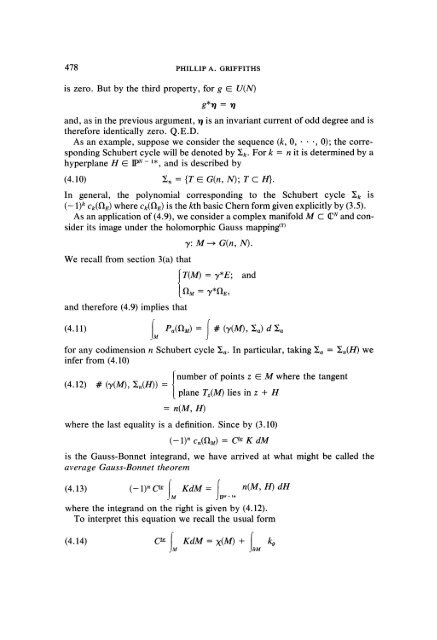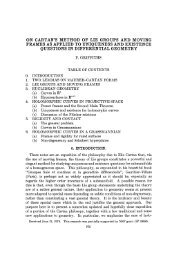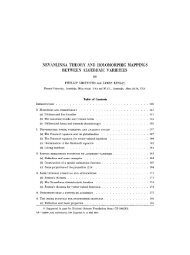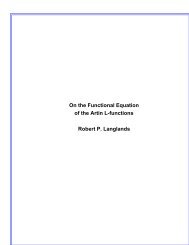View PDF - Project Euclid
View PDF - Project Euclid
View PDF - Project Euclid
You also want an ePaper? Increase the reach of your titles
YUMPU automatically turns print PDFs into web optimized ePapers that Google loves.
478 PHILLIP A. GRIFFITHS<br />
is zero. But by the third property, for g U(N)<br />
g*q q<br />
and, as in the previous argument, a is an invariant current of odd degree and is<br />
therefore identically zero. Q.E.D.<br />
As an example, suppose we consider the sequence (k, 0, ., 0); the corresponding<br />
Schubert cycle will be denoted by Xk. For k n it is determined by a<br />
hyperplane H IPu 1,, and is described by<br />
(4.10) 2;, {T G(n, N); T C/.<br />
In general, the polynomial corresponding to the Schubert cycle Xk is<br />
(- 1) c(fl) where c(12) is the kth basic Chern form given explicitly by (3.5).<br />
As an application of (4.9), we consider a complex manifold M C (I2 N and consider<br />
its image under the holomorphic Gauss mapping r<br />
We recall from section 3(a) that<br />
y" M---> G(n, N).<br />
T(M)<br />
fM<br />
y’E; and<br />
and therefore (4.9) implies that<br />
IM (4.11) Pa(M) (y(M), Xa) d ,a<br />
f#<br />
for any codimension n Schubert cycle Xa. In particular, taking a<br />
infer from (4.10)<br />
n(H) we<br />
(4.12) # (y(M), Xn(H))<br />
number of points z M where the tangent<br />
plane Tz(M) lies in z + H<br />
n(M, H)<br />
where the last equality is a definition. Since by (3.10)<br />
(--1) n Cn(nm) C te K dM<br />
is the Gauss-Bonnet integrand, we have arrived at what might be called the<br />
average Gauss-Bonnet theorem<br />
(4.13) (-1),cte IM KdM In n(M, H) dH<br />
where the integrand on the right is given by (4.12).<br />
To interpret this equation we recall the usual form<br />
(4.14) cte IM KdM=x(M) + IOM kg
















